Cottage gardens have a unique charm with rustic elegance and natural beauty. These compact, informal spaces blend with various plants that combine several colors, textures, and fragrances. In this article, we’ll explore the elements that make cottage gardens so enchanting and provide inspiration for creating your own.
15 Inspirational Cottage Gardens
Traditionally found near the front or back door of quaint cottages, cottage gardens have evolved to suit various home styles. See how versatile these classic gardens can be in the examples showcased below.
Robust Diversity
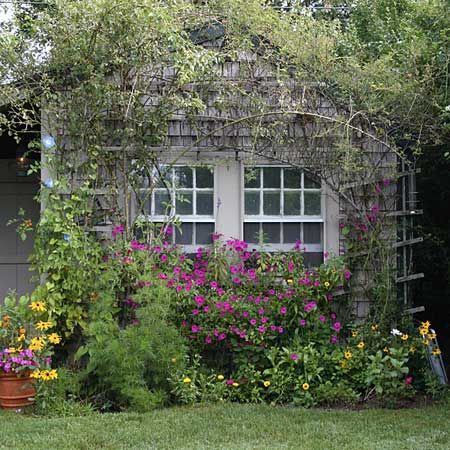
Classic cottage gardens typically feature a diverse mix of annuals, perennials, roses, shrubs, vines, and even vegetables. Unlike formal gardens that aim to impress with strict symmetry, cottage gardens have an effortless blend of plants. The key to achieving this look is to embrace a variety of plant types while maintaining a cohesive color palette and giving each plant enough room to thrive.
To create a cottage garden, consider incorporating plants with different heights, textures, and bloom times. This approach provides visual interest throughout the seasons. Popular choices include hollyhocks, delphiniums, foxgloves, and climbing roses. Intersperse these with lower-growing plants like lavender, catmint, and dianthus to create a lush, layered look. Mixing in edible plants such as herbs and vegetables can add both beauty and utility to your garden space.
Follow the Brick Road
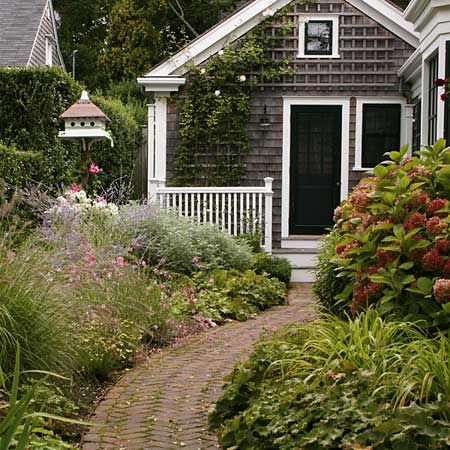
Pathways are necessary for many cottage gardens for practical access and as design elements. In this example, bricks laid in a diagonal herringbone pattern form a curving path that divides two wide borders. This winding design adds visual interest and invites exploration, while the herringbone pattern provides detail.
Natural stone, gravel, or even grass paths can work well in a cottage garden setting. Remember to keep paths wide enough for comfortable passage and maintenance access. The addition of focal points, such as the charming hipped-roof birdhouse seen here, draws the eye upward and adds vertical interest to the garden.
Structural Grace
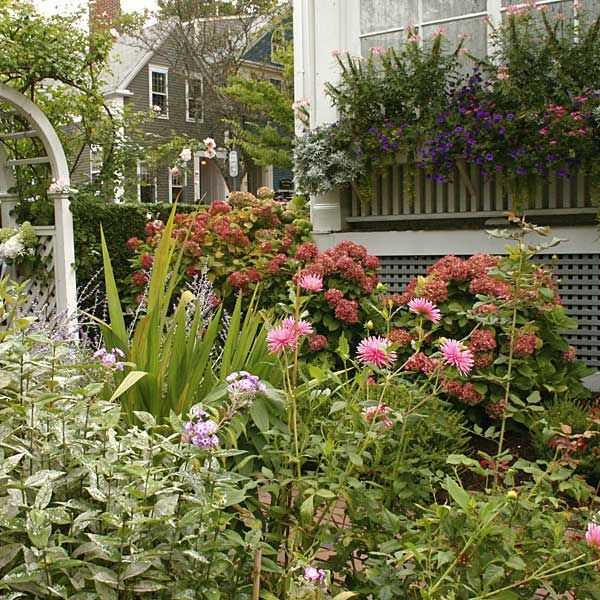
While cottage gardens typically have an informal appearance, adding structural elements can provide additional planting areas. In this garden, the arbor serves as both a vertical accent and a support for climbing roses, adding height to the garden. The neatly trimmed privet hedge acts as a living fence, providing a crisp green backdrop that allows the colorful blooms to stand out.
To achieve a similar effect in your garden, you can use arbors, trellises, or obelisks. Pair these structures with a mix of plants that offer long-lasting color, such as the hydrangeas, garden phlox, and window box annuals seen in the above photograph.
Made for Shade
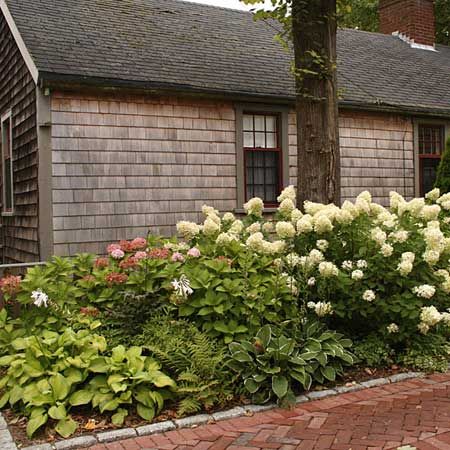
Cottage gardens aren’t limited to sunny locations. You can transform shaded areas into lush, inviting spaces with the right plant selection. This garden showcases a beautiful shade-tolerant border framed by Belgian block edging. The combination of ‘Annabelle’ hydrangeas, hostas, and ferns creates a serene and textural display that thrives in low-light conditions. Hostas can provide a variety of leaf colors and patterns, while ferns add a delicate, lacy texture to the mix. Planting shade-loving flowering plants like astilbes or columbines can add pops of color to your shaded garden.
Summer Romance
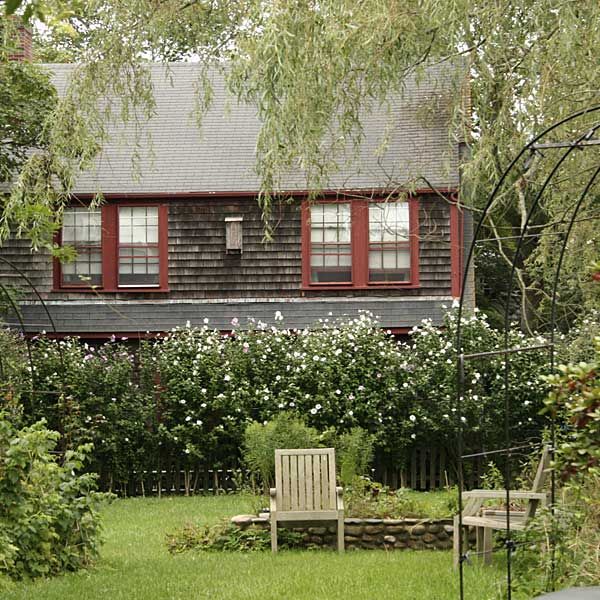
Late summer is a magical time in cottage gardens, and this scene captures the essence of that romance. Under the graceful canopy of a weeping willow, a row of late-flowering pink and white rose of Sharon shrubs creates a stunning privacy screen. Rose of Sharon (Hibiscus syriacus) offers large, showy flowers in late summer when many other plants have finished blooming. By planting them closely together, you can create an effective and beautiful living fence. The weeping willow provides dappled shade, creating a perfect spot for relaxation.
To recreate this romantic summer look, consider incorporating plants with a long-blooming season or those that flower later in the summer. Pair them with trees or shrubs that offer interesting forms or foliage to maintain visual interest throughout the year.
Brilliant Border
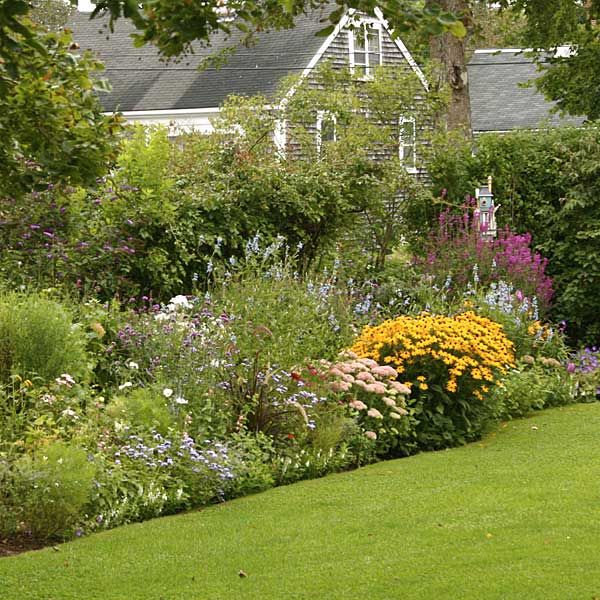
A vibrant border is the hallmark of a classic cottage garden, and this example showcases some favorite perennials that create a stunning display. Black-eyed Susans (Rudbeckia), pink-flowering sedum, and pale-blue delphinium form a colorful tapestry around the lawn. Place taller plants like delphiniums toward the back of the border, medium-height plants like black-eyed Susans in the middle, and lower-growing plants like sedum at the front.
The combination of yellow, pink, and blue seen here is classic and harmonious. Remember to include plants with different bloom times so your garden gets continuous color throughout the growing season. Adding a mix of annuals and perennials will help you achieve that.
Green Peace

While most associate cottage gardens with lots of colorful flowers, this example shows how a mostly green palette can shine. The cedar-shingled cottage’s low-maintenance cobblestone courtyard is a study in verdant hues, from the plants to the painted trim. Using various shades and textures of green adds depth and interest without relying on bright blooms.
The cobblestone courtyard adds texture and old-world charm while requiring minimal upkeep. This type of hardscaping is ideal for small spaces or areas where traditional lawns might be impractical. Introducing evergreen shrubs can provide structure and keep your space lush year-round.
Casual Classic
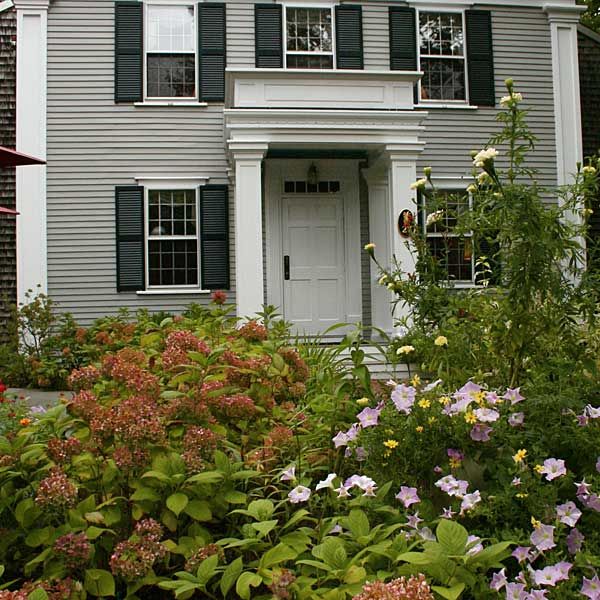
This Greek Revival dwelling showcases how a cottage garden can soften the formality of classical architecture. The down-to-earth garden design takes the edge off the home’s stately appearance, creating a welcoming and approachable atmosphere.
When designing a cottage garden for a more formal home, use elements that bridge the gap between the architectural style and the informal garden aesthetic. This might include symmetrical plantings near the house that gradually become more relaxed as they extend into the garden. Use classic cottage garden plants like roses, peonies, and lavender to keep your home’s traditional feel while adding some personality.
Remember to scale your plantings in relation to your house. Taller plants and climbing varieties can help visually connect a grand facade with the garden below.
Country Charm
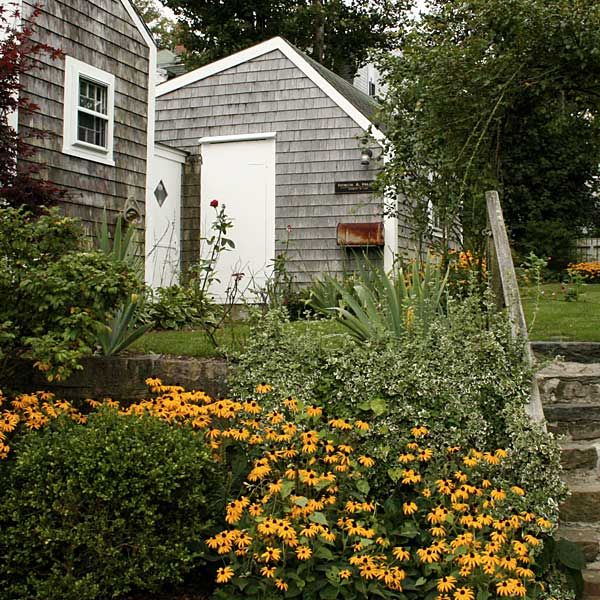
This charming country garden exemplifies the cottage style with its diverse mix of plants and rustic elements. Golden Rudbeckia (black-eyed Susans) take center stage, attracting butterflies and adding a bright splash of color. The garden is further enhanced by a compact Japanese maple, neatly trimmed boxwood, iris foliage, and a rose-covered arbor. You can use boxwood hedges to define spaces within the garden or create a more formal edge to flower beds.
Don’t forget to use inorganic elements to add character and charm. The stonework, timeworn mailbox, and lozenge-shaped window on the back door all contribute to the garden’s appeal. These details help to create a sense of history and lived-in comfort that is essential to the cottage garden aesthetic.
Daring Hues
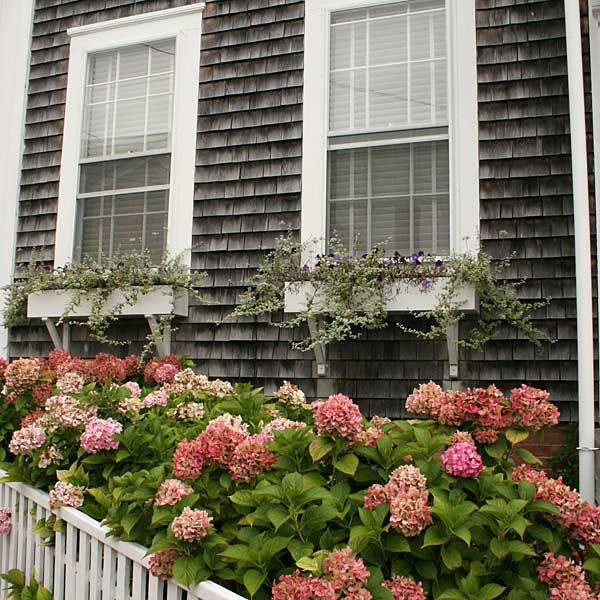
This striking example shows how a simple planting scheme can create a bold impact in a narrow space. A row of hydrangeas provides a dramatic display of color, changing an overlooked area into a focal point of the garden. Hydrangeas are excellent choices for cottage gardens, providing large, showy blooms in a variety of colors. By planting a single variety in a row, you can create a cohesive look that doesn’t overwhelm a small area.
Remember that the soil pH can affect the color of some hydrangea blooms, allowing you to adjust the hue to complement your overall garden design. Pairing with complementary perennials adds more interest and layers to your narrow garden space.
My Blue Heaven
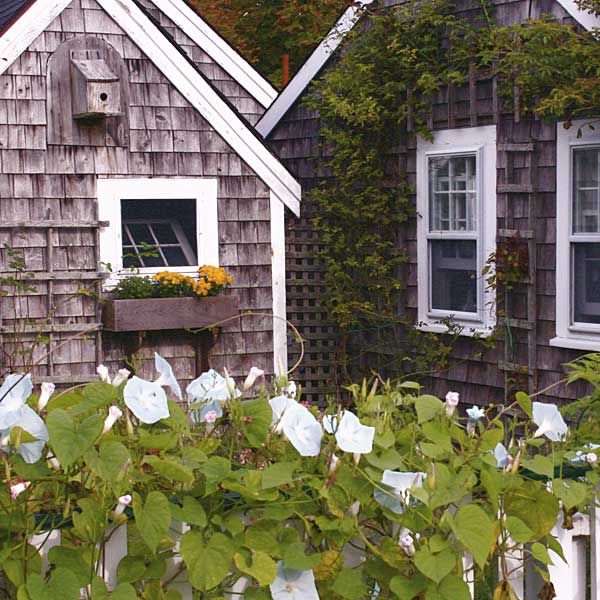
This enchanting scene showcases the beauty of ‘Heavenly Blue’ morning glories along a white picket fence. The heart-shaped foliage and vibrant blue flowers are simple and content, embodying the essence of cottage garden charm. Morning glories are an excellent choice for cottage gardens, offering rapid growth and abundant blooms. You can easily grow them from seed, making them a cost-effective option for covering fences, trellises, or arbors. The ‘Heavenly Blue’ variety is particularly stunning, with its clear sky-blue flowers that open in the morning and close in the afternoon.
Enhance the look with additional climbing plants like sweet peas or clematis for a diverse and lush appearance.
Splashes of Color
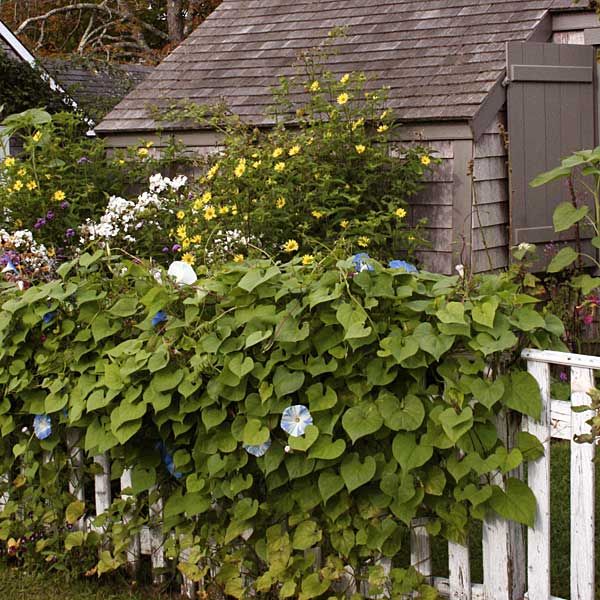
This vignette shows how tall cottage classics can create a stunning display against a rustic backdrop. Lemon-yellow daisies and fragrant white phlox stand out beautifully against the silvered shingles of a cedar-shake outbuilding, creating a perfect balance of color and texture. The contrast between the bright flowers and the weathered wood of the outbuilding adds depth and character to the scene.
To get a similar effect in your garden, consider planting tall perennials that will grow to eye level or above.
Uniformity Is Boring
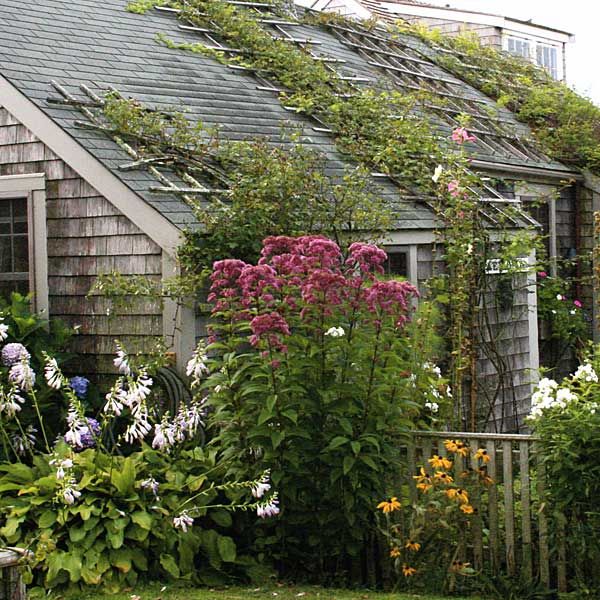
This garden exemplifies the cottage garden principle that diversity reigns supreme. A wide range of plants, including roses, annuals, perennials, and shrubs, share the limelight, creating a rich tapestry of colors, textures, and heights. From left to right, we see hostas, statuesque eupatorium, black-eyed Susans, snowy phlox, and towering hollyhocks (nearly gone to seed) harmonizing in the yard of a rose-covered retreat. This diverse planting scheme gives your space interest throughout the growing season and attracts a variety of pollinators to your garden.
This approach creates visual interest and helps your garden remain resilient to pests and diseases that might affect a single species. Including heirloom and native plant varieties encourages biodiversity and sustainability in your garden.
Enchanting Entry
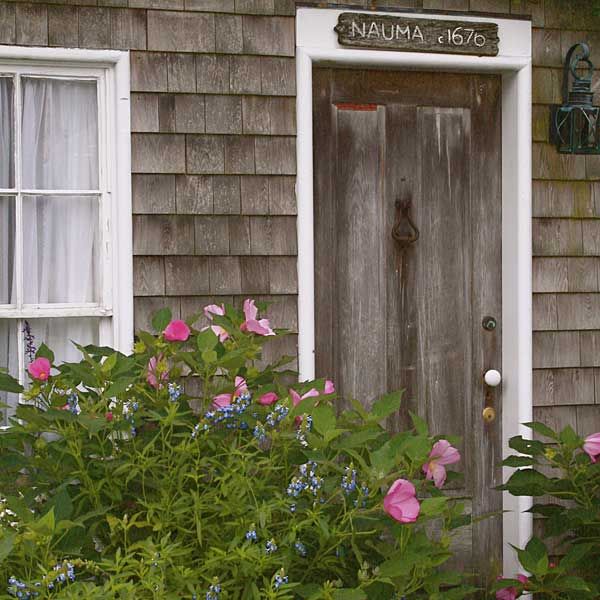
First impressions matter, and this cottage garden entry makes a stunning statement with billowing pink hibiscus blossoms greeting visitors by the front door. The lush, tropical appearance of the hibiscus adds an unexpected twist to the traditional cottage garden aesthetic. Hibiscus plants come in several colors and you can grow them in containers in colder climates, allowing you to bring them indoors during winter.
Color Study
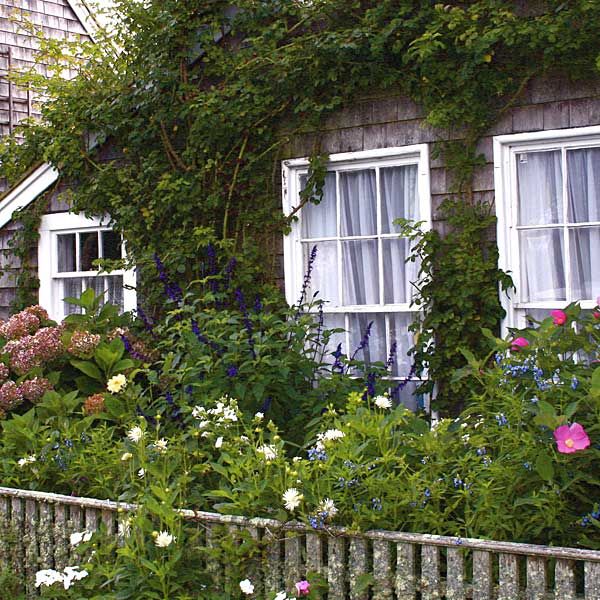
This beautiful garden shows how limiting the color palette can create a harmonious and sophisticated cottage garden look. By focusing on just two or three hues—in this case, pink, blue, and cream—the garden achieves a cohesive and visually pleasing effect.
Foliage can also contribute to your color scheme. Silver-leaved plants, for example, add a cool, calming element to a warm-colored garden, while dark green foliage provides a rich backdrop for pastel blooms.
Our Conclusion
Cottage gardens offer a delightful blend of informal charm and carefully curated beauty. By using a diverse mix of plants, embracing architectural elements, and playing with color schemes, you can create a garden that’s visually stunning. Whether you have a sprawling country yard or a small urban plot, you can adapt the principles of cottage gardening to suit your space and style.
